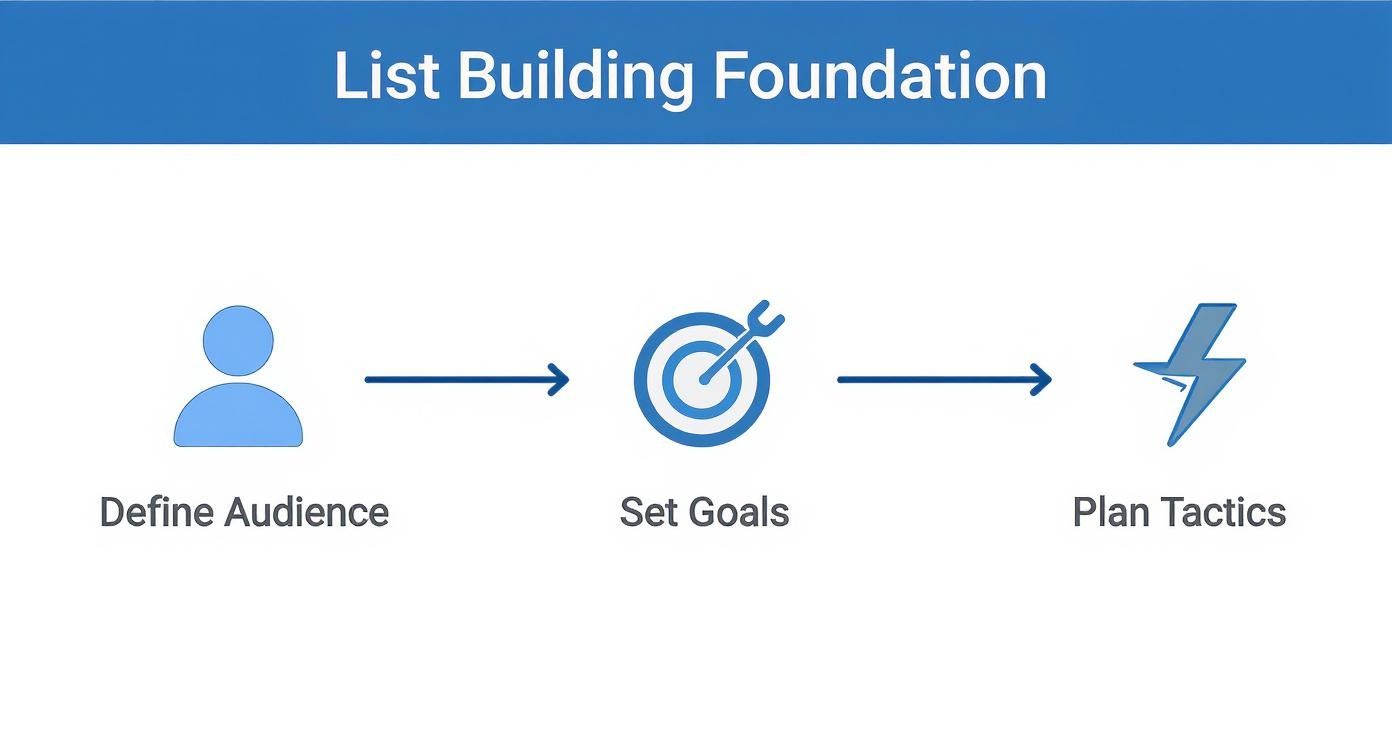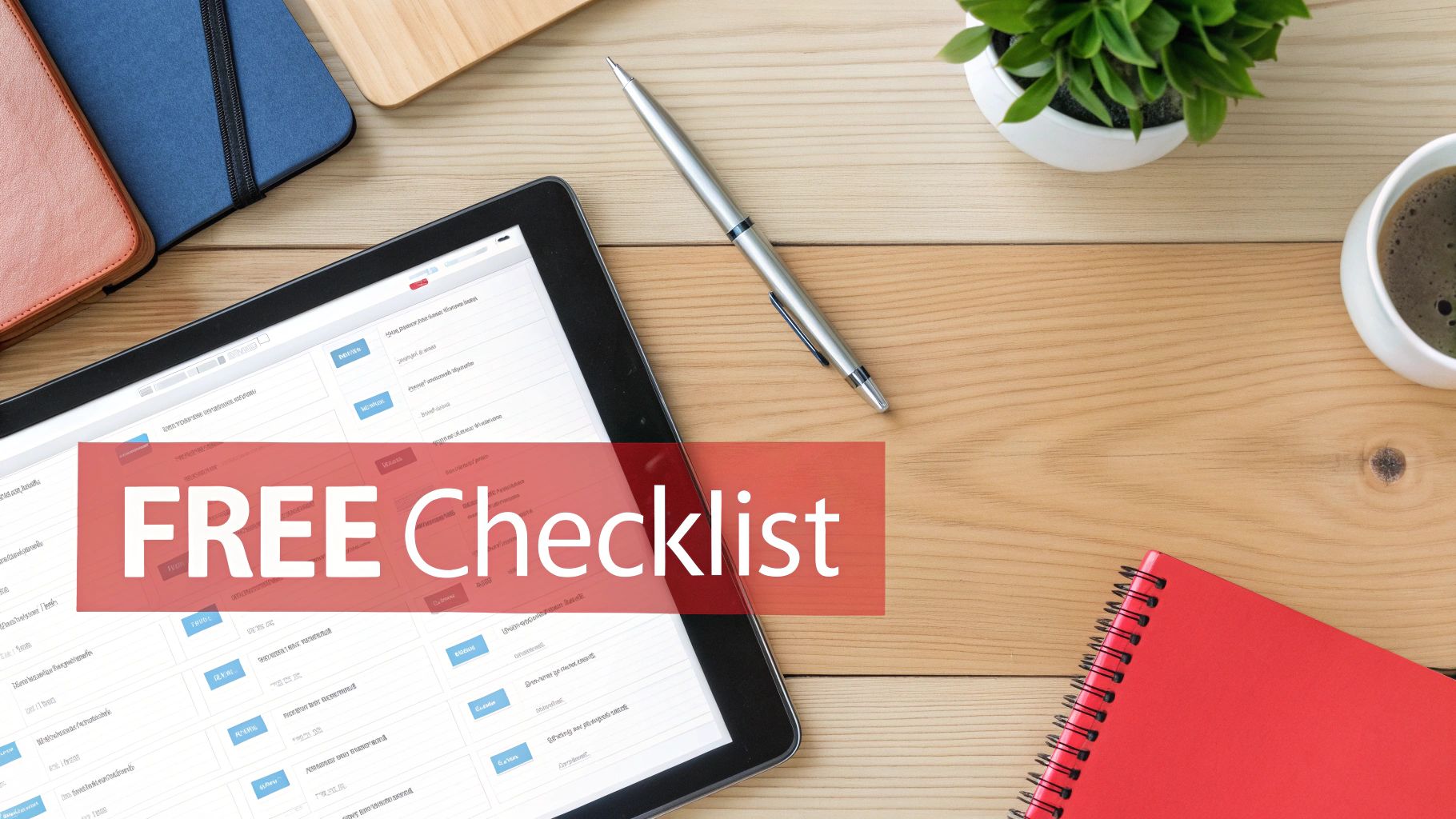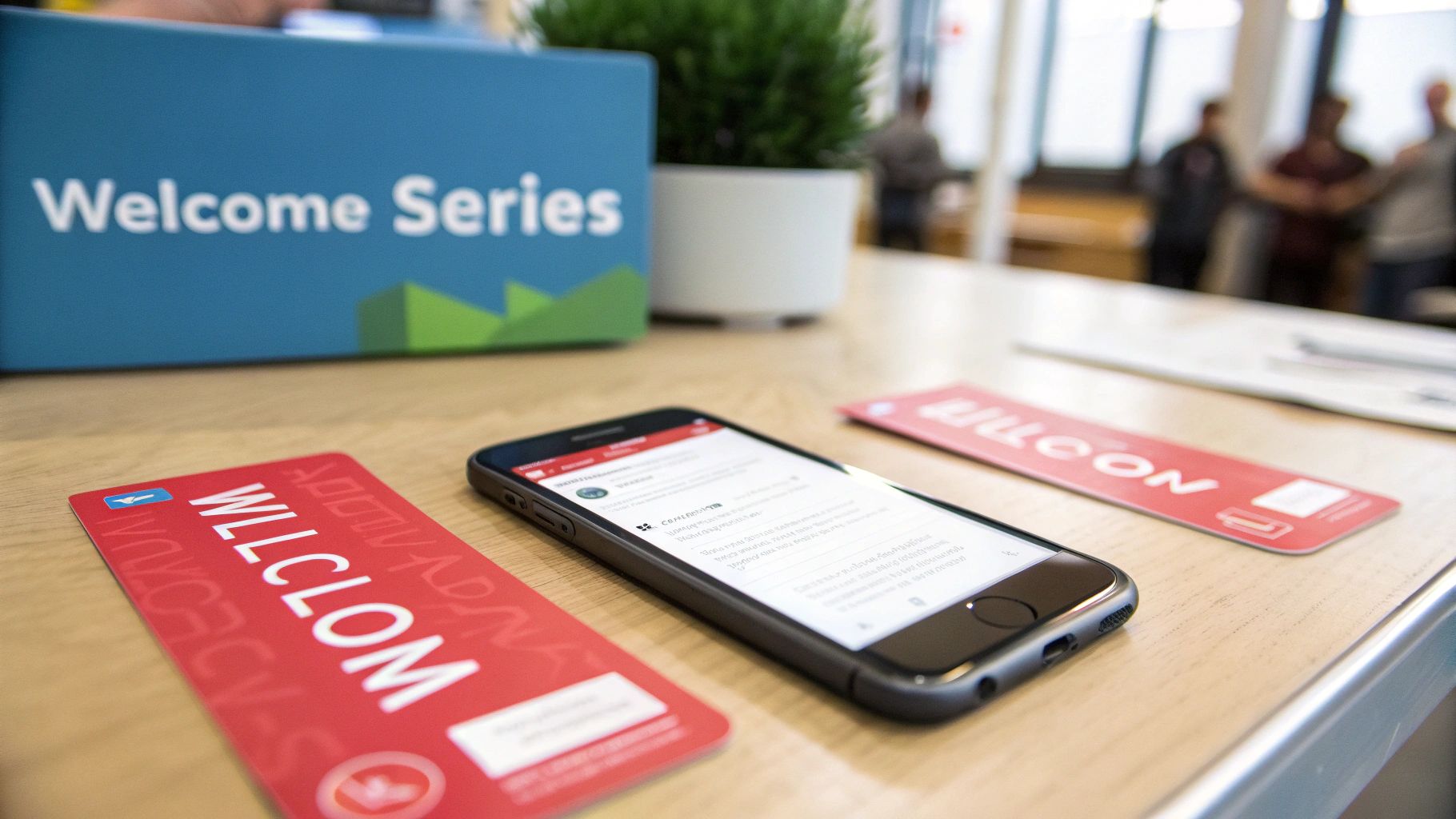How to Build an Email List: Grow Subscribers Fast
To build an email list that actually delivers, you first need a solid plan. It's tempting to jump straight into collecting emails but without a clear strategy focused on your ideal audience and measurable goals, you’ll just end up with a list of names, not a powerful asset.
Building Your Foundation for List Growth
Before you even think about chasing subscribers, you need to lay the groundwork. Skipping this step is like setting off on a road trip without a map – you might get somewhere , but it probably won't be where you intended to go and you'll waste a lot of time and fuel getting there.
The absolute cornerstone of your plan is figuring out precisely who you want to attract. A huge mistake I see all the time is businesses trying to appeal to everyone. In reality, this just means you end up appealing to no one. You have to get specific and build a detailed subscriber persona .
Define Your Ideal Subscriber
And I mean really define them. Go beyond basic demographics like age and location. You need to get inside their head and understand their real-world challenges, professional goals and what keeps them up at night.
Ask yourself:
- What specific problems are they trying to solve right now?
- What sort of information are they actively Googling?
- Where do they hang out online? (Is it LinkedIn, specific industry forums or Instagram?)
- What kind of content do they actually value? (Are they looking for practical guides, deep-dive case studies or quick checklists?)
Think about it this way: a motorsport sponsorship agency isn't just targeting 'businesses'. Their ideal subscriber is probably something like a 'Marketing Manager at a UK-based challenger brand looking to increase brand visibility through non-traditional sports partnerships'. See how that level of detail completely changes your approach?
Your subscriber persona is your North Star. It dictates the content you create, the channels you use to promote your list and ensures every offer you make is perfectly aligned with what your audience actually wants and needs.
Set Clear and Measurable Goals
Once you know who you're talking to, you need to define what success looks like. Vague goals like "grow our email list" are useless because they aren't actionable. Get specific. Set measurable objectives that you can track over time.
This simple three-step process is the bedrock of any successful list-building strategy.

As you can see, it all starts with the audience, which then informs your goals and, finally, your tactics.
Your goals should look more like this:
- Achieve a 5% month-on-month subscriber growth rate .
- Generate 20 marketing-qualified leads from our email list each quarter.
- Maintain an average open rate of over 40% .
These kinds of metrics give you real benchmarks to measure your performance against. This focused approach is paying off, too. The year-on-year growth of B2B email lists in the UK has jumped by 23% , largely driven by smarter, more targeted strategies. The best-performing lists are also regularly cleaned to maintain data quality, which is crucial for protecting your sender reputation and keeping response rates high.
If you want to dive deeper into the nuts and bolts of it, check out this comprehensive guide on building email lists.
Creating Lead Magnets People Actually Want
Let’s be honest, an email address is personal. People guard it closely and won’t hand it over for just anything. If you want to build a high-quality email list, you need to offer something genuinely useful in return.
This is where your lead magnet comes in. It’s not just a sign-up incentive; it’s a high-value resource that solves a specific problem for your ideal subscriber. The days of a simple "sign up for our newsletter" are long gone. You need to create something that provides immediate value and quietly demonstrates your expertise.
The Value Exchange
Think of it as a transaction. Your potential subscriber is "paying" with their email address and, crucially, their permission to be contacted. Your end of the deal is to deliver something so helpful they feel like they’ve won. This first exchange sets the tone for the entire relationship.
A powerful lead magnet nails three things at once:
- It solves a real problem. It hits a specific pain point your audience is feeling right now.
- It provides a quick win. They can use it immediately and see a tangible benefit.
- It positions you as an expert. It shows you know your stuff and builds trust from the get-go.
Tailoring Offers to Specific Audiences
Generic advice falls flat. The real power of a lead magnet is in its specificity. A one-size-fits-all download just won’t cut it if you’re trying to attract a niche audience. You have to create resources that speak directly to their world.
Let's look at a few UK-based examples:
- For a motorsport team: A general guide to racing is white noise. But a downloadable "UK Track Day Preparation Checklist" ? That’s gold for amateur racers and track day fans. It's hyper-specific, incredibly useful and talks their language.
- For a Cornish tourism agency: A generic "Travel Guide" will be ignored. But a "Family Holiday Planner for Cornwall" with a sample itinerary, budget tracker and a list of rainy-day activities for the kids? That’s a game-changer for their ideal customer.
- For an automotive specialist: A simple discount is okay, but an exclusive video tutorial on "How to Prepare Your Classic Car for a Winter MOT" is far better. It provides actionable advice and establishes their authority instantly.
The best lead magnets feel like they were made just for the person downloading them. They speak to an immediate need, making the decision to subscribe a no-brainer.
This kind of tailoring shows you understand your audience on a deeper level. It builds a foundation of trust before you've even sent your first proper email.
Popular Lead Magnet Formats That Work
While the content itself is king, the format you choose matters. It affects how your offer is perceived and, more importantly, how easily it can be used. Different formats appeal to different people, so the goal is to make your expertise as accessible and practical as possible.
To help you decide, here's a quick look at some of the most common lead magnet types and who they work best for.
Choosing the Right Lead Magnet for Your Audience
A comparison of common lead magnet types, their typical audience and the key benefits of each to help you select the most effective option.
| Lead Magnet Type | Best For Audience... | Key Benefit |
|---|---|---|
| Checklists & Planners | Needing actionable, step-by-step guidance. Perfect for complex tasks. | Provides a clear, easy-to-follow process that delivers an immediate sense of accomplishment. |
| Templates & Worksheets | Looking to save time and effort. Ideal for tasks like budgeting or content planning. | Offers a practical tool that users can put to work straight away, reducing friction and guesswork. |
| Exclusive Video Tutorials | Who are visual learners or need to see a process demonstrated. | Delivers high-perceived value and can explain complex topics more effectively than text alone. |
| Free Consultations | Seeking personalised advice for a high-value problem. Suited to service-based businesses. | Generates highly qualified leads who have a specific need and are actively seeking solutions. |
| Ebooks & White Papers | Wanting an in-depth understanding of a topic. Good for B2B audiences. | Establishes deep authority and provides comprehensive value, positioning your brand as a leader. |
Ultimately, the best format is the one that aligns perfectly with the subscriber persona you defined earlier. When you craft an irresistible offer that solves a genuine problem, you're not just collecting emails—you're starting a valuable conversation with people who are genuinely interested in what you have to say.
Designing Sign-Up Forms That Convert
You’ve got a killer lead magnet ready to go but it’s your sign-up form that acts as the gateway to your email list. The design, placement and wording of that form can be the difference between a happy new subscriber and a frustrated visitor clicking away for good. A clunky form will completely undermine all the effort you’ve put into creating a valuable offer.

The goal here is simple: make the sign-up process feel effortless and intuitive. You need to grab attention and persuade visitors to act without getting in their way. This means being smart about where you put your forms and how you present them.
Strategic Placement for Maximum Impact
Just having a sign-up form somewhere on your site isn't enough. It needs to be where your most engaged visitors are going to see it. Randomly scattering forms across your website is a surefire way to get ignored. Instead, think about high-traffic, high-intent locations.
A few prime spots I’ve seen work time and again include:
- Within popular blog posts: If an article is pulling in serious traffic, it’s the perfect place to offer a related lead magnet. For instance, a blog post about track day etiquette could feature a sign-up for your "UK Track Day Preparation Checklist".
- In the website header or footer: These are the standard, predictable spots where people look when they want to stay in touch. They might not be your highest converters but they provide a consistent, site-wide opportunity.
- As a non-intrusive exit-intent pop-up: This type of form only appears when a user’s cursor moves towards the ‘close’ button. It’s a last-chance effort to capture their details before they leave, often with a compelling offer to make them think twice.
The key is to match the form’s placement with the user's context. A well-placed form feels helpful and timely, not interruptive. It anticipates a need and offers a solution at precisely the right moment.
Best Practices for Form Design
Once you’ve picked your locations, the design of the form itself takes centre stage. The name of the game is minimising friction. Every extra field you ask for, every confusing word you use, increases the chance of a potential subscriber giving up. Keep it simple.
To get your design right, focus on these core elements:
- Use Minimal Fields: Ask only for what you absolutely need. An email address is usually enough to get started. Research shows that forms with just three fields can hit a conversion rate of at least 25% . You can always gather more info later as you build the relationship.
- Write Persuasive Microcopy: The text on and around your form is incredibly important. Use clear, benefit-driven headlines like "Get Your Free Holiday Planner" instead of a generic "Subscribe Now". Every single word should reinforce the value of signing up.
- Craft a Compelling Call-to-Action (CTA): Your CTA button should be impossible to miss. Use a contrasting colour and action-oriented text. Ditch "Submit" and try something more specific like "Send Me the Checklist!" or "Get Instant Access". This makes the benefit of clicking crystal clear.
Your form is a critical piece of a much larger conversion system. To see how forms, CTAs and overall page design work together, check out our deep dive into the anatomy of a high-converting landing page.
Continuously Optimise with A/B Testing
Designing your form isn’t a one-and-done job. To truly understand what resonates with your audience, you need to test different versions. This process, known as A/B testing , involves showing two variations of your form to different segments of your audience to see which one performs better.
You don't need complicated tools to get started. Most modern email marketing platforms have built-in A/B testing features, letting you test simple changes that can have a huge impact.
Consider testing elements like:
- The CTA button colour: Does a green button outperform a red one?
- The headline copy: Does "Download Your Free Guide" convert better than "Get Our Exclusive Ebook"?
- The number of fields: Does asking for a name significantly hurt conversions?
By continually testing and refining, you can methodically improve your form's performance, ensuring you’re turning as many visitors as possible into valuable subscribers. This iterative approach is fundamental to building a healthy email list for the long haul.
Using Multiple Channels to Find Subscribers
Relying on your website traffic alone to build an email list is like fishing in a single pond. To really speed things up, you need to cast a wider net and meet potential subscribers where they already are. A multi-channel approach brings in a steady flow of high-quality leads from different places, meaning you're not over-reliant on any one platform.

This means actively promoting your list and lead magnets everywhere your ideal audience hangs out. From social media feeds to in-person events, every single touchpoint is an opportunity to invite someone into your world. By diversifying your efforts, you build a much more resilient and effective list-building engine.
Turn Social Media Followers into Subscribers
Your social media followers have already shown they’re interested in your brand but that connection can be pretty fleeting. The real goal is to move that relationship onto a more direct and reliable channel by turning them into email subscribers. This takes more than just occasionally posting a link to your sign-up page.
You need to actively sell the value of joining your list.
- Promote Your Lead Magnets Directly: Don’t just talk about your newsletter; share your best lead magnets. Create engaging posts, stories or reels that spotlight the exact problem your checklist or template solves and finish with a clear call-to-action to download it.
- Run Engaging Contests: A giveaway is a seriously powerful incentive. Offer a prize that's relevant to your industry and make an email subscription a mandatory entry requirement. This can bring in a huge, rapid influx of new leads.
- Use Platform Features: Make it dead simple for people to sign up. Add a sign-up link to your Instagram bio, use the call-to-action button on your Facebook page and share sign-up forms directly in relevant LinkedIn groups.
The key is to weave your list-building efforts seamlessly into your day-to-day social media strategy. This kind of consistent promotion turns passive followers into active, engaged members of your email list.
Integrate Sign-Ups into Paid Advertising
Paid advertising on platforms like Meta and Google is a powerful way to reach a highly targeted audience well beyond your organic reach. Instead of pushing all that traffic to a sales page, you can run ad campaigns specifically designed to build your email list. This allows you to capture leads first and nurture them over time.
A brilliant way to do this is by running lead generation ad campaigns . These ads are optimised for capturing contact information right there within the platform. A user can often subscribe with just a few clicks without ever leaving Facebook or Instagram, making the whole process incredibly smooth.
By using paid ads to promote a high-value lead magnet, you are essentially paying to acquire a long-term asset. You get a new subscriber you can build a relationship with, which is often far more valuable than a one-off sale.
For example, an automotive tuning specialist could run a targeted Meta ad for their "Stage 1 Tuning Guide" aimed at owners of specific car models in the UK. This attracts precisely the right audience and adds them to a list for future marketing.
Explore Offline and Partnership Opportunities
Not all subscribers will come from online sources. Offline events and strategic partnerships can be absolute goldmines for acquiring highly engaged leads. These methods often involve face-to-face interaction, which helps build a much stronger initial connection.
Think about where your ideal customers gather in the real world.
- Trade Shows and Events: If you attend industry events, have a simple way to collect email addresses. A tablet with a sign-up form or a QR code linking to a landing page works a treat. Offer an exclusive piece of content or a prize draw for those who sign up on the day.
- Strategic Partnerships: Team up with a complementary, non-competing business. For instance, a wedding photographer could partner with a local venue to cross-promote each other’s email lists to their respective audiences. This gives you access to a warm, relevant audience you couldn’t reach on your own.
This kind of real-world engagement adds a personal touch that digital methods can't always replicate.
The proof of these email-first strategies is in the results. For example, the London-based skincare startup By Sarah London grew its email list by 72% in just six months using tactics like quizzes and sample offers. While the average UK small business sees Instagram engagement of just 1-2% , their email open rates consistently hit 40-55% . It just goes to show how powerful a direct line to your audience can be. Discover more insights about email list building tactics on sageminietech.com.
How to Nurture and Segment New Subscribers
Getting someone to sign up is a huge win but it’s really just the start of the conversation. The real value in your email list comes from what happens next. The way you welcome, guide and nurture that new relationship determines whether they become a loyal fan or just another number that hits ‘unsubscribe’.
The first, most critical step is to build a compelling welcome email sequence . This isn't just about delivering the download they signed up for. It’s your chance to make a brilliant first impression, show off your brand’s personality and set clear expectations for what’s to come.
Crafting an Effective Welcome Sequence
That first email needs to land in their inbox instantly. No delays. It has to deliver the promised goods—whether it's a checklist, video or discount code—without any fuss. But a truly great welcome sequence goes much deeper, aiming to build a genuine connection from day one.
To get started, think about a simple three-part series:
- The Instant Delivery: This email delivers the lead magnet and offers a warm, personal welcome. Keep it short, friendly and focused on providing that immediate value.
- The Brand Introduction: A day or two later, send an email that tells your story. Who are you? What do you stand for? Share your mission or a key insight that shows them they’re in the right place.
- The Expectation Setter: In the final email of the sequence, let them know what kind of content they can expect and how often. This transparency is brilliant for building trust and stops future emails from feeling like an unwelcome surprise.
This initial sequence is your most powerful tool for engagement. It's when subscribers are most receptive, so use it to showcase your value and start a real conversation.
The Power of Smart Segmentation
As your list grows, treating everyone the same stops working. A one-size-fits-all message simply won’t connect with a diverse audience and that's where segmentation comes in. It’s the simple practice of dividing your list into smaller, more focused groups based on what you know about them.
By segmenting your audience, you can send hyper-relevant content that speaks directly to their specific interests or needs. This simple act of personalisation can dramatically boost your engagement.
A segmented list is a powerful asset. It allows you to move beyond generic broadcasts and deliver personalised experiences that make each subscriber feel seen and understood, which is the key to long-term loyalty.
You can segment your list based on all sorts of criteria. Some of the most effective methods include:
- How they signed up: Group subscribers based on the lead magnet they downloaded. Someone who grabbed your "UK Track Day Preparation Checklist" is interested in different content from someone who downloaded a "Motorsport Sponsorship Guide".
- Their stated interests: You can simply ask people to tick a few boxes on the sign-up form itself. A tourism business, for example, could ask if they’re interested in family holidays, adventure travel or luxury breaks.
- Their engagement level: Create segments for your most active readers and another for those who haven’t opened an email in a while. This lets you reward your fans and run re-engagement campaigns for the subscribers who've gone quiet.
Understanding how to tailor your messaging is essential. For a deeper look, our guide on personalisation in email marketing can help boost open rates and drive real results.
Using Automation to Nurture Leads
The good news is that setting up these systems doesn’t have to be a manual, time-consuming job. Simple automation workflows can handle the nurturing process for you, ensuring every new subscriber gets a consistent and valuable experience. Your welcome sequence is your first automation but you can build on that foundation.
For example, you could set up a workflow that sends a follow-up email a week after someone downloads a resource, offering them a related blog post. It’s a simple touch that reinforces your expertise and keeps your brand top-of-mind.
This consistent nurturing pays off. In 2025, while average UK email open rates are a healthy 40% to 55% , the real impact is financial. For small businesses, each subscriber can generate an average of £30 to £40 per year , with higher returns directly linked to consistent, valuable communication. By automating the nurturing process, you create a scalable system for turning new leads into valuable customers.
Choosing Your Tools and Staying GDPR Compliant
To really get an email list off the ground, you need the right tech. It doesn’t have to be a complicated setup but it does need to be solid enough to handle subscribers, automate some of the legwork and—most importantly—manage people's data responsibly.
The heart of your toolkit will be an Email Service Provider (ESP) . Think of platforms like Mailchimp or ConvertKit as the command centre for your whole email operation. They do everything from sending out your campaigns to keeping your subscriber database in order. You can dig deeper by checking out our guide to the top 10 best free email marketing platforms for 2025. Alongside a good ESP, dedicated landing page builders can be a lifesaver, letting you create slick sign-up pages without needing to be a web developer.

Navigating GDPR in the UK
Having the right tools is only half the battle, though. If you're collecting data from anyone in the UK, you absolutely have to comply with the General Data Protection Regulation (GDPR). This isn't just a suggestion; it's a legal requirement designed to protect both you and your subscribers. Getting it wrong can lead to hefty fines and, worse, completely wreck the trust you’ve worked so hard to build.
At its core, compliance comes down to a few straightforward principles. You can't just add someone to your list without their clear, unambiguous permission.
Here’s what’s non-negotiable:
- Get Explicit Consent: People have to actively opt-in. That means no pre-ticked boxes. They must physically tick a box themselves to agree to receive your marketing emails.
- Have a Clear Privacy Policy: Your policy needs to be easy to find and even easier to understand. It should spell out what data you’re collecting and exactly how you plan to use it.
- Make Opting Out Simple: Every single email you send must have a clear and obvious way for people to unsubscribe. No hoops to jump through.
Think of GDPR not as a barrier but as a framework for building a quality list. By being transparent and respectful, you end up with subscribers who genuinely want to hear from you. And let's be honest, that's the only kind of list worth having.
A Few Common Questions We Hear About Building an Email List
When you're diving into building an email list, a few questions always seem to pop up. Let's tackle some of the most common ones with clear, straight-to-the-point answers based on what we see work in the real world.
How Often Should I Email My List?
There’s no magic number here. The right frequency comes down to your audience and what they expect from you.
A great place to start for most businesses is once a week. It’s enough to stay on their radar without becoming inbox noise. If you're in e-commerce, you might dial that up to two or three times a week during a big sale. For a service-based business, a high-value bi-weekly or monthly newsletter could be perfect.
The real key is consistency . Set an expectation when people sign up and then stick to it.
What Is a Good Sign-Up Form Conversion Rate?
It’s always good to have a benchmark. While rates can vary wildly from one industry to another, a solid target to aim for with your sign-up form is between 1% and 5% .
If you have a really compelling lead magnet, you can often push that closer to 10% . We've even seen highly optimised, dedicated landing pages break the 20% barrier.
Don't get fixated on hitting a specific number. The goal is constant improvement. If you're sitting below 1%, take it as a clear sign to start A/B testing your offer, headline and call-to-action to see what clicks with your visitors.
Should I Use Single or Double Opt-In?
This one’s a classic debate. A single opt-in adds someone to your list the second they hit 'submit' – it's fast and frictionless. A double opt-in makes them click a confirmation link in a follow-up email first.
Here’s the breakdown:
- Single opt-in gets you more subscribers, faster. The downside? You can end up with lower-quality leads, typos in email addresses and more spam complaints.
- Double opt-in builds a more engaged, higher-quality list. Every subscriber has actively confirmed they want to hear from you.
For the long-term health of your list and better email deliverability, the double opt-in is almost always the smarter move. It's a small bit of friction that pays off handsomely down the line.
Ready to build a powerful email list that drives real growth? Superhub specialises in creating bespoke digital marketing strategies that connect you with your ideal audience. Get in touch today to see how we can help.





